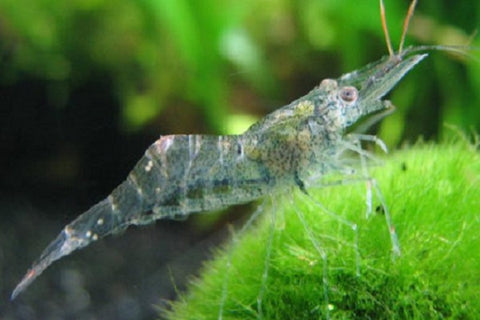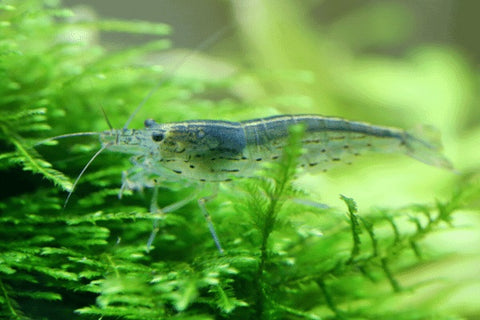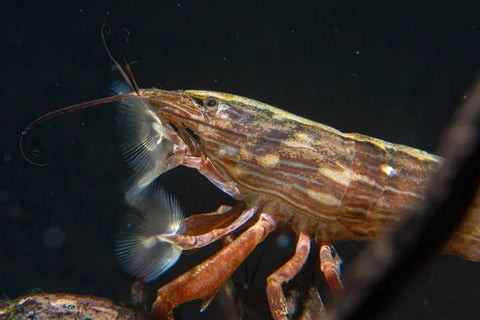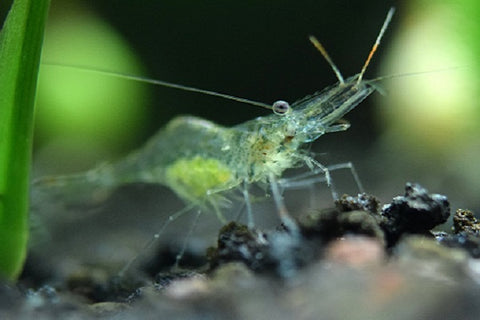It is quite challenging for any aquarists to have a proper care consideration before setting a tank for any fish. Taking sufficient caring measures after regular interval makes sure the natural growth and happy life of your fish. In this article, we are going to cover some crucial points about caring for Ghost Shrimp.
Ghost shrimp are freshwater fish that belong to the Palaemonetes family. They are found to be active in various parts of your tank when providing proper decorative materials inside the tank. Ghost shrimp are cute and have many benefits, raising them at home is easy and fun. They are a great addition to any tank; they do not require any special care. These shrimp can eat almost anything, and they come in many different colors.
Basic information about ghost shrimp

1. Lifespan and size
Ghost shrimp's average life span is about one year which means these species cannot live longer. But in some special cases, they can live more than one year as well. The females are the typically larger of the sexes and can easily reach up to 1.7-2 inches in length, while the males are typically smaller, but can still grow to a size that reaches about 1.5 inches.
2. Appearance
Ghost shrimp is a fish with a very interesting and peaceful appearance. The body of this animal is flattened, and the head is much wider than the tail. Ghost shrimp look like little insects - small body, big head, and wide tail. They are transparent in color but most of the ghost shrimps have a colored spot behind their back. In females, you would find green color marks.
3. Habitat
Ghost shrimp like a natural environment with vegetation and live plant. They actively grow in freshwater. They are usually from the lakes of North America and there are plenty of ghost shrimp fish species found in the saltwater
4. Behavior
Ghost shrimp are peaceful and passive that’s why they live independently in the tank. They are algae cleaner, eating access to algae from the bottom of the tank. Moreover, they like to swim all around the tank. They are not aggressive, which makes them ideal tank mates for other fish.
5. Diet
Ghost shrimp's eating habits and their behavior can vary depending on how many times a day they are fed. They are scavengers, feeding on dead or live plants, as well as algae and detritus. Ghost shrimp also eat fish food, including flakes, pellets, and frozen foods. They will also eat snails that come near the surface of the water and are attracted to lights.
As for the food itself, it should be prepared with a fresh vegetable and/or seafood mixture. Crushed peas and lettuce are common foods for ghost shrimp, but they also love vegetables such as zucchini and cucumber
6. Water parameters
It is important to look at water parameters when it comes to proper care of your ghost shrimp. There should be proper considerations for water parameters before adding ghost shrimp to the aquarium. There are the following three things you should maintain as an aquarist.
- pH- 7.0 to 8.0
- Water temperature- 60-80 degrees Fahrenheit
- Water hardness- 3-7
Tank setup for ghost shrimp

Ghost Shrimp tank setup is super simple and can change over time to fit your needs.
- Your tank setup is probably ideal for ghost shrimp - live plants and a small amount of fish waste will do just fine. Other than that, your tank setup sounds fine.
- Shrimp are best kept in tanks without a lot of water movement - canister filters are best for them. They also should not be kept in tanks that are densely planted with fast-growing plants like java ferns, which will eventually overtake their tank and suffocate them.
- Shrimp can sometimes be difficult to catch, but they will come to rest on the bottom or sides of the tank if you have a light on; they sometimes are attracted to red or black light if you have such an option available.
- You can also keep the lights on during the day and shut them off at night if you like - just make sure to give them a few hours after turning off the lights before doing any water changes to avoid stressing them out.
- The only tricky thing is keeping it at the right temperature and humidity levels. To keep the temperature stable and high enough, use a small submersible heater.
- The under-gravel filter does a good job at keeping the water clean and aerated for your shrimp.
1. Tank Size
The minimum tank size that you can use for ghost shrimp is 5 gallon. Since ghost shrimps are small, so you can use around 4-5 shrimp per gallon of water. This means you have the choice to add 5 different variants of ghost shrimp in the tank.
2. Tank equipment
It is important to get the right tank equipment for your ghost shrimp. The right fish tank equipment allows you to live a healthy and fun life with your ghost shrimp. You should try to think about what is going to be best for your ghost shrimp. Below is the list of tank equipment that you may use for ghost shrimp.
3. Tank Decorations
You can use a wide range of decorations items for your ghost shrimp to keep them engaged. Aquarists can use decorative stones, realistic scenery, background scenery, natural sand, live plants, and more.
Tank mates for ghost shrimp

Since ghost shrimp are non-aggressive and would like to live with the same beings. Some suitable tank mates for ghost shrimps are:
- Nerite snails
- Mystery snails
- Corys Ottos
- Bamboo shrimp
- Vampire shrimp
Ghost shrimp common diseases
Ghost shrimp are prone to a variety of diseases, both bacterial and viral. The most common diseases of ghost shrimp are usually contracted via the water but can also be contracted via contact with infected fish or other shrimp. The most common diseases in ghost shrimp are:
1. White spot/Ich
This is mostly developed when your shrimp is old. If your shrimp has White Spot, this will be the indication of the end of their neural life span. The other reason may be due to the molting and these white spots are not completely white when appears on the ghost shrimp’s body. On the other hand, ich may not occur in ghost shrimp themselves, however, it might be coming from the tank having ich.
2. Head and lateral line erosion
Head and lateral line erosion or having a hole in the head is a fish disease that may be developed due to activated carbons, heavy metals, parasites, endotoxins, and others. To avoid the disease in ghost shrimp, aquarists must do a regular water change to reduce the number of activated carbons.
3. Velvet
Velvet is a fish disease that is due to parasites (dinoflagellate parasites). The parasite imparts a dusty or partial gold color to fish. There should be needed to do effective measures to avoid the diseases like increasing water temperature, adding aquarium salts, using dim lights, and making sure that you are not doing carbon filtration during the treatment period.
Ghost shrimp tank maintenance

There are a few things to remember when doing maintenance of your tank.
- Take out water from your tank and put it in a bucket, so that you can rinse the tank and get clear water.
- Clean all decorations. It doesn't matter how old they are, they still need to be cleaned. This is because they collect dust and bacteria.
- Clean the actual tank (the glass) with a microfiber cloth, and make sure to get all the dust off. You can use soap to clean it, but make sure it is soap without chemicals.
- Remember to change out at least 10% of your water weekly or bi-weekly. You don't want the water to stay stagnant for too long, because your ghost shrimp will have a higher chance of getting sick.
Breeding
When breeding ghost shrimp, you'll need:
- 2 male and female adult ghost shrimp
- 1 tank with a lid
- 1 air stone
- 1 filter (optional)
- 1 heater (optional)
- 1 plastic container or tank divider to use as a "nursery" for the babies.
You will need to move the female to the breeding tank. make sure there are no other fish or shrimp are there. Close the breeding tank and move them directly. Female shrimp will lay their eggs once they get stressed. It will take 21 to 24 days for the egg to hatch.
The tank or container should ideally be opaque, so the babies stay in the dark. It can be a simple plastic container or a separate tank.
Final Words
In the above article, we have discussed in detail the ghost shrimp care guidance. For aquarists, we provided information on how to set up a tank and what size they can use as a beginner.
There are some common foods also mentioned that you can use to feed your ghost shrimp. Moreover, before adding the ghost shrimp to the tank, it's important to use suitable equipment for the tank to avoid any discomfort.
Later in the article, we come up with common diseases. It is crucial to avoid fish diseases in your ghost shrimp with appropriate care actions.
Finally, we provide you with breeding requirements for ghost shrimp for effective reproduction.
Hope this article can help you better take care of your ghost shrimp.

